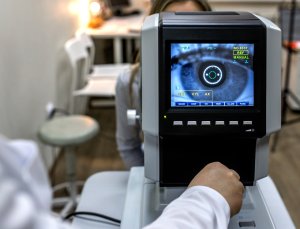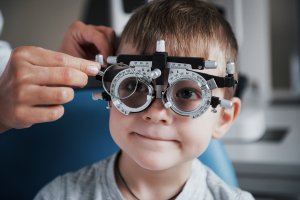Accommodative Esotropia

Voted Best of Berks—
eight years in a row!
Your child has been diagnosed with accommodative esotropia. This is a common condition which tends to occur in children two years of age or older.
Symptoms
Esotropia means the eyes are turned inward relative to each other.
You may notice the inward turning of the eye at all times or only sometimes. The inward turning may be more noticeable when your child looks at things up close.
You may notice that either eye turns in. However, in some children it appears that only one eye turns inward.
Accommodative indicates that the inward turning of the eyes is caused by the child focusing (accommodating) his or her eyes. A farsighted child can focus his or her eyes to adjust for the farsightedness. However, the focusing effort required to see clearly causes your child’s eyes to cross.
Therefore, the amount of inturning varies with the amount of effort with which your child is focusing. Some children with accommodative esotropia avoid having their eyes cross by rarely focusing their eyes. However, when they see a small, interesting object these children will focus their eyes in order to see clearly, and their eyes will cross. Sometimes a child will close an eye in order to avoid seeing double when that eye turns inward.
Treatment
Glasses
Glasses appropriate to your child’s farsightedness are given to reduce the focusing effort needed to see clearly. Therefore, while wearing the glasses your child can see clearly without his or her eyes crossing. It is important that your child wears his or her glasses at all times.
A child who does not wear glasses will continue to cross his or her eyes. It is felt that children whose eyes are not aligned will eventually lose the ability to use their eyes together. At this point glasses will not correct the esotropia and surgery will be necessary.
Bifocals
Bifocals may be prescribed if your child still has a significant amount of esotropia for close work even while wearing “regular” glasses.
Patching
If your child has amblyopia, or “lazy eye,” then patching is necessary in order to improve the vision in the amblyopic or “lazy” eye. A child with untreated amblyopia will never be able to use their eyes together and will not have a good long-term result.
Surgery
In some children glasses improve but do not completely correct the inward turning of the eyes. If the eyes are not straight while wearing the proper glasses then surgery may be considered.
Common Questions and Concerns
- My child will not wear the glasses!
Getting used to the glasses is the most difficult part. The first two weeks are critical. Your child must wear glasses at all times. It is important to be gentle but firm with your child during this period. Cable temples which wrap around the back of the ear will encourage your child not to remove the glasses. Putting toy glasses on your child’s favorite stuffed animal or doll also helps. Keep it up! When your child gets used to the glasses wearing them will become routine. Please do not be discouraged. The difficulties are temporary but the results are lifelong.An uncomfortable fit is the most common reason children refuse to wear their glasses. You should obtain a child’s frame which fits comfortably. Frequent adjustments are required. As your child grows the earpiece may become too short and may need to be adjusted or replaced.Of course, if you are concerned that the glasses are not the correct prescription or do not fit well we will be happy to re-check them for you. - My child’s eyes are straight while wearing the glasses but cross when we remove the glasses for bedtime!Glasses do not cure your child’s farsightedness, they simply straighten your child’s eyes by relaxing the focusing reflex. When your child removes the glasses he or she again has to focus in order to see clearly. In fact, after wearing glasses your child will be used to seeing clearly at all times. Therefore, your child probably will make a strong focusing effort in order to see clearly without their glasses. This focusing effort results in crossing. The only cure is for your child to out grow the problem (see question 3).
- Will my child outgrow this condition?Some children do indeed outgrow accommodative esotropia. However, it takes several years and usually not before 9-12 years of age or older. Children do not outgrow accommodative esotropia in only a few months.It is difficult to predict which children will outgrow their need for glasses. Most children who are very farsighted will always require glasses, even if the glasses are only used to improve vision and not to correct esotropia. Contact lenses can be substituted for glasses when your child becomes a teenager.About half the children who require bifocals eventually outgrow the need for these bifocals.
- Why hasn’t the doctor recommended surgery to get rid of these glasses and cure my child?All children with esotropia are not alike. Surgery may be right for some children with esotropia but may not be the right option for your child. We avoid surgery in a child whose eyes are always straight while wearing their glasses. Surgery is avoided because there is a real risk of your child’s eyes turning out or becoming “wall-eyed” as they grow older and become less far-sighted.
Not every condition is listed. Consult Dr. Goldberg if you have any questions about a condition not described here.
Find a Doctor
Physician information including education, training, practice location and more.
Schedule an Appointment
Call 800-762-7132 or make an appointment online.





